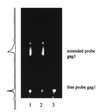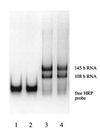Detection of HIV-1 RNA by nucleic acid sequence-based amplification combined with fluorescence correlation spectroscopy
- PMID: 8917501
- PMCID: PMC24002
- DOI: 10.1073/pnas.93.23.12811
Detection of HIV-1 RNA by nucleic acid sequence-based amplification combined with fluorescence correlation spectroscopy
Abstract
Nucleic acid sequence-based amplification (NASBA) has proved to be an ultrasensitive method for HIV-1 diagnosis in plasma even in the primary HIV infection stage. This technique was combined with fluorescence correlation spectroscopy (FCS) which enables online detection of the HIV-1 RNA molecules amplified by NASBA. A fluorescently labeled DNA probe at nanomolar concentration was introduced into the NASBA reaction mixture and hybridizing to a distinct sequence of the amplified RNA molecule. The specific hybridization and extension of this probe during amplification reaction, resulting in an increase of its diffusion time, was monitored online by FCS. As a consequence, after having reached a critical concentration of 0.1-1 nM (threshold for unaided FCS detection), the number of amplified RNA molecules in the further course of reaction could be determined. Evaluation of the hybridization/extension kinetics allowed an estimation of the initial HIV-1 RNA concentration that was present at the beginning of amplification. The value of initial HIV-1 RNA number enables discrimination between positive and false-positive samples (caused for instance by carryover contamination)-this possibility of discrimination is an essential necessity for all diagnostic methods using amplification systems (PCR as well as NASBA). Quantitation of HIV-1 RNA in plasma by combination of NASBA with FCS may also be useful in assessing the efficacy of anti-HIV agents, especially in the early infection stage when standard ELISA antibody tests often display negative results.
Figures








References
-
- Sarngadharan M G, Popovic M, Bruch L, Schüpbach J, Gallo R C. Science. 1984;224:506–508. - PubMed
-
- Weiss S H, Goedert J J, Sarngadharan M G, Bodner A J, Gallo R C, Blattner W A. J Am Med Assoc. 1985;253:221–225. - PubMed
-
- Ranki A, Valle S L, Krohn M, Antonen J, Allain J P, Leuther M, Franchhini G, Krohn K. Lancet. 1987;ii:589–595. - PubMed
-
- Salahuddin S Z, Markham P D, Redfield R R. Lancet. 1984;ii:1418–1420. - PubMed
-
- Mayer K H, Stoddard A M, McCusker J, Ayotte D, Ferriami R, Groopman J E. Ann Intern Med. 1986;104:194–196. - PubMed
Publication types
MeSH terms
Substances
LinkOut - more resources
Full Text Sources
Other Literature Sources
Medical
Research Materials

